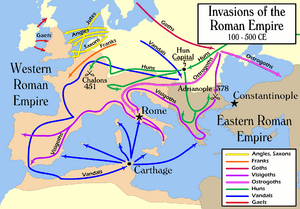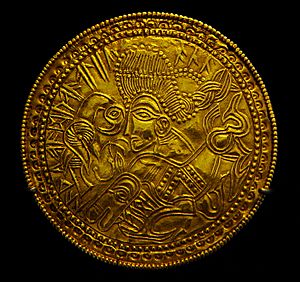Migration period facts for kids
The Migration Period was a time of big changes in Europe. It lasted from about 300 CE to 700 CE. This period marked the end of Ancient history and the start of the Middle Ages. It's also sometimes called the "Barbarian Invasions" or "Völkerwanderung," which means "wandering of peoples" in German.
What Were the Migrations?
During the Migration Period, many different groups of people moved across Europe. These groups included the Goths, Vandals, and Franks. They were mostly Germanic peoples. Other groups like the Bulgar and Slavic tribes also moved.
Historians think several things caused these movements. Attacks by the Huns from the east might have pushed people westward. Changes in climate or too many people in one area could also have played a role.
Some groups, like the Angles, Saxons, Frisians, and Jutes, moved to Britain. These movements changed the map of Europe a lot.
Later Migrations
Even after 700 CE, people kept moving. Waves of Slavs, Alans, Avars, Bulgars, Hungarians, Pechenegs, Cumans, and Tatars moved into Eastern Europe. These later migrations changed the mix of people in those areas.
Historians who focus on Western Europe often study the migrations that had the biggest impact there.
Related Topics
Images for kids
-
Migration of early Slavs in Europe between the 5th–10th centuries.
-
Migration and settlement of the Bulgars during the 6th–7th centuries AD
-
Slavic fibula brooch made of copper dating back to the Migration Period, c. 600-650 AD
See also
 In Spanish: Período de las grandes migraciones para niños
In Spanish: Período de las grandes migraciones para niños






